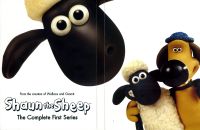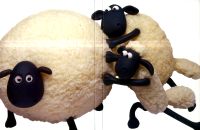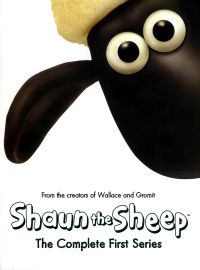
15.7.2013 #565
by Guido Bibra
• Making Of Shaun the Sheep
• Snout, Trotter & A Curly Tail - How to Build a Pig
• Meet the Animals
![]() The Movie
The Movie
Animals have always been one of the favourite subjects of animated movies and even Aardman, the british masters of stop-motion, always had a particular fondness for anthropomorphised characters. The early projects of the studio in the 1970s and 1980s were not particularly animal-centric, but one filmmaker had radically changed this. When Nick Park arrived at Aardman in 1985, he had brought his unfinished thesis film with him - the adventures of an inventor called Wallace with his clever Dog Gromit, who became the blueprints for many other plasticine characters. While working on other projects, Nick Park had finally finished A Grand Day Out in 1989 together with Creature Comforts, in which animated animals are interviewed about their life and living conditions. It was Creature Comforts which won the Oscar for best animated short film in 1991 and not I, but it was the latter one which became more famous over the years.
In 1993, Nick Park had finished The Wrong Trousers, which introduced the first animal villain to the world of Wallace and Gromit, the sinister penguin mastermind Feathers McGraw, who is out to do a daring jewel heist. But it was the third Wallace & Gromit movie, A Close Shave, which introduced one lasting character in 1995: an unnamed sheep taking refuge in Wallace's house. After the turbulent events of the movie, Wallace names the intruder Shaun and makes him a permanent resident, while the whole herd is still in their house. Wallace & Gromit took a long break after the third movie, while Aardman and Dreamworks worked on their first cinema outing Chicken Run, which became a huge success in 2000, paving the way for a full-length Wallace & Gromit adventure on the big screen.
In preparation for the movie, Aardman produced ten two-minute shorts with Wallace & Gromit to get the animators familiarized with the characters after such a long break. In one of the shorts, Shaun makes a comeback, presumably still at 52 West Wallaby Street as a house guest, but he did not appear in The Curse of the Were-Rabbit, which came to the big screens in 2005. But Aardman already had plans for Shaun, who was to star in his very own television show. Creature Comforts had already been turned into a successful tv series since 2003 and the same concept of short, less than ten minute long episodes was also chosen for Shaun the Sheep, except for one difference: while Creature Comforts was all dialogue, the new stories about Aardman's sheep flock would be completely without text.
The production of Shaun the Sheep went into preparation shortly after Curse of the Were-Rabbit was finished, freeing up a lot of resources at Aardman's Bristol studio, where all their films and series are made. Nick Park, who had invented Wallace, Gromit and Shaun, was not closely involved in the making of the new series, instead handing over the reins to Richard Goleszowski, who had been working as an animator for Aardman since the early 1990s and had successfully helmed the production of the new Creature Comforts series. On Shaun the Sheep, he collaborated with the married team of Alison Snowden and David Fine, who already had a long career of animated children's television. While Creature Comforts was made for ITV, Shaun the Sheep had been commissioned by the BBC, who had found an unlikely production partner in the German television station WDR through an European Union funding program.
Shaun the Sheep was primarily intended as a children's series and was to be broadcast on CBBC and the German children's channel KiKa, but Aardman had been able to convince the budget providers to make the series also accessible to adults, so that they could watch together with their children and, in turn, also become a target audience. The goal of being entirely children-friendly while providing underlying satire and in-jokes for adults had always been a speciality of Aardman especially with Wallace & Gromit, but with Shaun the Sheep the concept needed to be taken to an entirely new level. The goal was to tell a mini-story in the confinement of only six minutes runtime - something which proved to be simultaneously very easy and incredibly hard, especially considering it had to be done fourty times alone for the first series.
The stories were written by a multitude of british television writers familiar with children's programming, but many ideas were also contributed by the Aardman staff. The ideas ranged from very simple things to real short adventure stories, but each one had the typical Aardman cleverness and a lot of room for physical and visual gags. Without any dialogue except for bleating, growling, squealing and grunting, the writers were able to condense an enormeous amount of plot into the very short runtime of only about six minutes.
The result is sheer fun not only for children, but also for adult viewers, as the humour is intelligent enough to work on both levels and there are a lot of underlying pop-culture references in almost each episode, which are often so subtle that they completely pass by the younger viewers. Many ideas surrounding the sheep flock have been taken from Aardman's first cinema outing Chicken Run - especially the idea of the animals behaving like humans, which their owners are completely oblivious of, is one of the major running gags of Shaun the Sheep.
The stop-motion animation was produced by nearly the same team as Creature Comforts. Directional duties were split between Richard Goleszewski and Christopher Sadler, who like his colleague had been working for Aardman since the early 1990s. A team of about only a dozen animators, who had mostly been at the studio for a long time, worked on Shaun the Sheep together with cinematographer Charles Copping, also a veteran of the studio. The sets were designed by Michael Salter and Kitty Clay, taking real farm environments as a model and translating them into the trademark Aardman style. The scenery is not only limited to a sheep paddock - there is also the farmer's house with several rooms, the barn and sometimes the sheep travel to the city and other places. The scenery is never dull and always full of little surprises, which are often not even noticeable on the first view.
Like many other Aardman creatures, the design of the characters is very basic and almost abstract, but the simplicity makes them even more expressive, especially considering the fact that there is no real dialogue. Many of the characters are not only empty shells, but have distinct personalities - not every sheep of the large flock stands out, but apart from Shaun there are some who make their mark in the stories like Shirley, the giant eating machine and Timmy, the youngest sheep of the flock. The design of the sheep is, of course, based on the original Shaun from A Close Shave, who was only a variation of Gromit with wool - fortunately Aardman did not deviate much from this original concept.
Blitzer, the sheepdog, looks surprisingly different to Gromit - for once, he has a visible mouth and a much bigger nose, but like the sheep he divides his walking between on all fours and upright. He is actually a good friend of Shaun and helps to keep the flock together, but is always torn between loyalities to the sheep or his master. The unnamed farmer is portrayed as a somewhat clueless and simple man, who has no idea what is going on behind his back on the farm, providing a long-standing running gag of the whole series. The only other main characters are the three pigs, who are the nemesis of the sheep and often disturb and provoke the flock, making them the naughty antagonists of several stories.
None of the characters are really speaking - the animals can't and the humans just talk gibberish. But there are a lot of voices, which are provided by a small group of voice actors comprised of John Sparkes, Justin Fletcher, Kate Harbour, Rich Webber and Jo Allen. They give the characters more than just animal noises - it's an enormeously funny sort of textless dialogue, which really brings the animals and humans to life. Together with the often very complicated and innovative animation, the characters of Shaun the Sheep become one of Aardman's best creations.
Without dialogue, Shaun the Sheep also relies a lot on music. Each episode is introduced by a simple, but infectious sing-along title tune interpreted with gusto by comedian Vic Reeves - it's basically a stomping folk tune with a matching instrumentation heavy on guitars, harmonicas and, above all, banjos. The incidental music comes from the british composer Mark Thomas, who follows closely in this vein, adding jazz and orchestral sounds to the many variations of the title melody making up a set of generic tunes which are reused in different episodes. With the addition of several other themes composed exclusively for a couple of scenes, the music never sounds repetetive and boring.
Shaun the Sheep premiered on the BBC Children's Channel CBBC in March 2007 and was instantly rewarded with positive criticism, especially because the series was not exclusively geared towards children. The first twenty episodes were shown in March, while the other half of the first series was broadcast in September 2007. While the fourty episodes were shown very quickly with two on each consecutive days on their premiere, even in the beginning the series went into reruns almost immediately and became an intergal part of the CBBC program and was even shown sometimes on the regular BBC channels.
In Germany, the co-producing WDR commissioned a translated title song and made Shaun das Schaf a part of the popular children's program Die Sendung mit der Maus, but often cutting the episodes down to five minutes. The individual full-length versions were mostly shown firest on CBBC's German equivalent KiKa, sometimes even broadcasting episodes which had not yet been shown in England. Shaun the Sheep was also sold to almost thirty countries all over the world, at first even including the USA - Aardman had struck a lucrative deal with the Disney Channel, but this did not last very long and after low ratings and a general disinterest in the very british humour, the series vanished from the American television screens.
Since its premiere in spring 2007, Shaun the Sheep has already become a classic as popular as Wallace & Gromit. The hugely positive reaction to the first series led to fourty more episodes first broadcast in 2010 and in spring 2013 the first half of a third series was shown. But the fame of the intelligent British sheep will come to new heights in 2015, when the flock is going to storm the cinemas in their first full-length feature - for this reason, there will probably no new television adventures after 2013, but there are always 120 wonderful short episodes of Shaun the Sheep to look at.
![]() The DVD
The DVD
The complete first series of Shaun the Sheep was released on DVD in November 2008 and is actually a collection of the five previously available DVDs Shape up with Shaun, Off The Baa, Saturday Night Shaun, Abracadabra and Wash Day, which were released seperately between September 2007 and November 2008. There is no additional content, so there is no need to rebuy the set if you already have the separate releases, but as a collection the boxset is absolutely fine as well. While the fourty episodes could have easily fit on three discs or less, the BBC and 2Entertain have elected not to do a re-press, instead repackaging them in a thick, five-panel digipack enclosed by a sturdy cardboard box with a simple, but nice design.
While there are other releases like in the USA (only in cropped fulllscreen) and in Germany (only with German masters and soundtrack), the british release reviewed in this article remains the best version of Shaun The Sheep and is also the most inexpensive one - for less than ten british pounds you get the fourty episodes in their uncut original versions in perfect quality and also with some little extras. Because these are actually the five seperately released DVDs, the episodes are not in broadcast order, but due to the self-contained stories it does not really matter.
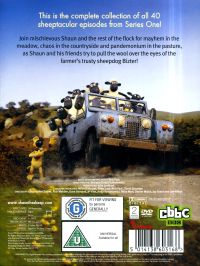

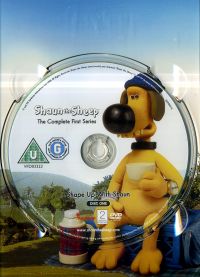
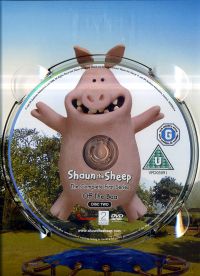
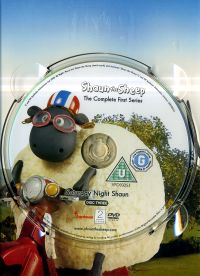
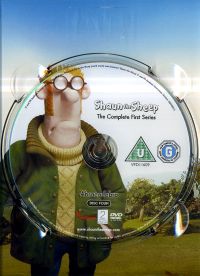
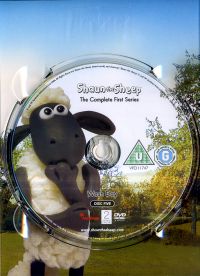
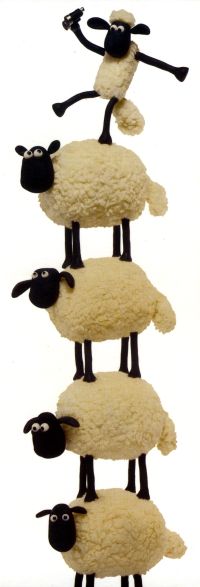
![]() Image
Image
Shaun the Sheep must have been one of the first Aardman productions utilizing digital video cameras. Curse of the Were-Rabbit had still been shot on 35mm film, but for cost reasons the switch to digital production on Shaun the Sheep was inevitable. But this does not hurt the visual quality at all - while series 1 was not yet post-produced in high-definition, Shaun the Sheep looks magnificent on these DVDs.
What we get here are presumably the digital broadcast masters encoded into the anamorphic DVD format at an aspect ratio of about 1.78:1 - actually a bit less, since the image is a little bit masked at the sides, but this is not distracting in any way. The image is progressively encoded at 25fps, but there are some isolated spots where it breaks out into interlaced mode, presumably because some post-production effect has been used. This happens only very infrequently and is barely noticable.
Sharpness is surprisingly good even without the use of an enhancement filter - the image really looks like photographed and is so detailed that sometimes little imperfections in the plasticine and scenery are visible. The colours are very strong and literally jump off the screen, while contrast and brightness are perfectly balances. The only visible noise is a little bit of video grain occuring sometimes in very dark scenes, but otherwise the image looks exceptionally clean. The authoring is also nearly perfect - because there is less than one hour of material on each disc, the bitrates are high enough not to make compression artifacts a problem in the first place.
The first series of Shaun the Sheep may still be a standard-definition video production, but thanks to the 16:9 format the series looks like it was made for the cinema. The quality on these DVDs is so good that they will look perfect even on larger screens.
![]() Sound
Sound
On the british DVDs, the first series of Shaun the Sheep comes equipped only with an English soundtrack - as far as the language goes the series is actually international save for its British title song.
The soundtracks are encoded in the standard 192 kbit/s and were mixed in plain stereo for the CBBC broadcasts, but like many television series it provides a surprisingly active surround sound. Most of it is created by the music, which seems to be intentionally leaking a lot to the rear channel, but there are also a few discrete surround effects in some episodes. But the frontal soundstage is also where the action is: the sound effects inhabit the whole width and are always directionally used - even the voices are not locked on the center channel. The overall sound appears very tame and not too loud, although there's a bit of crash and wallop during some of the more action-oriented sequences with a pronounced bass and some lofty trebles.
There's even a subtitle track for hearing-impaired viewers, transcribing every noise, bleat and grunt, which can be sometimes a bit strange.
![]() Extras
Extras
The original single-disc releases of the first series had a couple of short extras, which are replicated in this boxset. There are only three little featurettes and a sing-along, which is a bit disappointing considering the target audience are not only children.
Sing-Along (1:17) on disc one is a shoddily made karaoke video, even displaying the video in the wrong aspect ratio - it looks like a youtube video made by a fan.
Mini Making-Of (3:29) on disc two takes a very brief, but still interesting look behind the scenes of the Aardman studios in Bristol.
Snout, Trotter & A Curly Tail - How To Build A Pig (6:32) on disc three follows Aardman modelmaker Harriet Thomas demonstrating with a group of children how to make the clay models.
Meet the Animals (4:19) on disc four is a short introduction to the characters of the series and their models, which a group of visiting children are shown at the Aardman studios.
